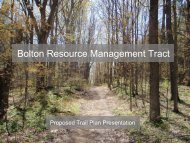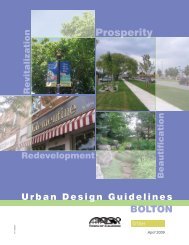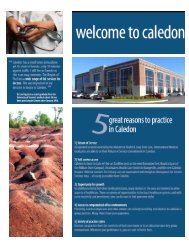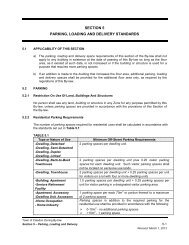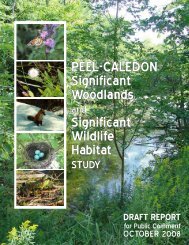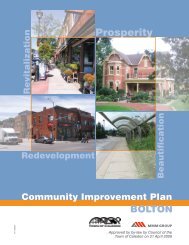TOWN OF CALEDON EMPLOYMENT LAND NEEDS STUDY
TOWN OF CALEDON EMPLOYMENT LAND NEEDS STUDY
TOWN OF CALEDON EMPLOYMENT LAND NEEDS STUDY
You also want an ePaper? Increase the reach of your titles
YUMPU automatically turns print PDFs into web optimized ePapers that Google loves.
7-3<br />
Table 7-1b summarizes Watson’s forecast of employment on employment lands over the shortterm<br />
and long-term forecast period, based on the conversion factors assigned to employment by<br />
ICI, as set out in Table 7-a.<br />
TABLE 7-1b<br />
<strong>EMPLOYMENT</strong> ON <strong>EMPLOYMENT</strong> <strong>LAND</strong>S, 2006-2031<br />
Percent Total Employment Growth on Employment<br />
Employment Growth by Sector<br />
Employment on<br />
Lands<br />
Employment by ICI 2006-2011 2006-2021 2006-2031 Employment Lands 2006-2011 2006-2021 2006-2031<br />
Primary 10 63 169 0% 0 0 0<br />
Work @ Home 868 2,030 3,544 0% 0 0 0<br />
Industrial 3988 11,894 18,598 97% 3,868 11,537 18,040<br />
Commercial 715 2,185 3,941 25% 179 546 985<br />
Institutional 351 909 1,479 10% 35 91 148<br />
Total 5,931 17,081 27,731 4,082 12,174 19,174<br />
Source: Watson & Associates, 2008.<br />
3. Determine the Density of Employment on Employment Lands<br />
Over the forecast period, there are a number of factors which are anticipated to influence the<br />
physical nature of development on employment lands across the Region of Peel. For example,<br />
it is foreseeable that higher density on employment lands could be achieved throughout the<br />
forecast period in the Region’s larger urban municipalities, largely due to the tightening of<br />
available employment land supply, increasing pressure for intensification. An increasing trend<br />
of office commercial uses in newer business parks is also likely to provide higher densities in<br />
employment areas with direct 400 series highway exposure, such as Mayfield West, when<br />
compared to older, heavier, traditional industrial areas. Furthermore, increases in industrial land<br />
values in Caledon (which have recently been experienced in South Albion-Bolton) will also tend<br />
to improve land utilization and increase employment density. On the other hand, existing trends<br />
within the Peel municipalities of Caledon and Brampton indicate that overall employment density<br />
has been, and will continue to be, heavily influenced by an increasing percentage of landextensive<br />
employment within the distribution and warehousing sector, which will tend to counter<br />
trends towards higher employment density.<br />
Given the above factors, forecast employment land density within the Town of Caledon is<br />
anticipated to be below many of the larger urban GTAH municipalities such as Brampton,<br />
Mississauga, and Vaughan, which range from approximately 14 to 24 employees per net acre<br />
Watson & Associates Economists Ltd.<br />
H:\caledon\2009 Employment Land Needs Addendum<br />
Report\Employment Land Needs Report_ammended as of November 13 2009.doc




